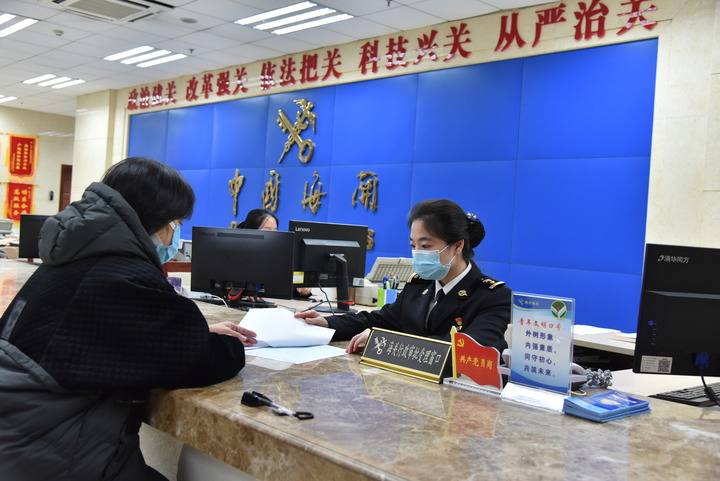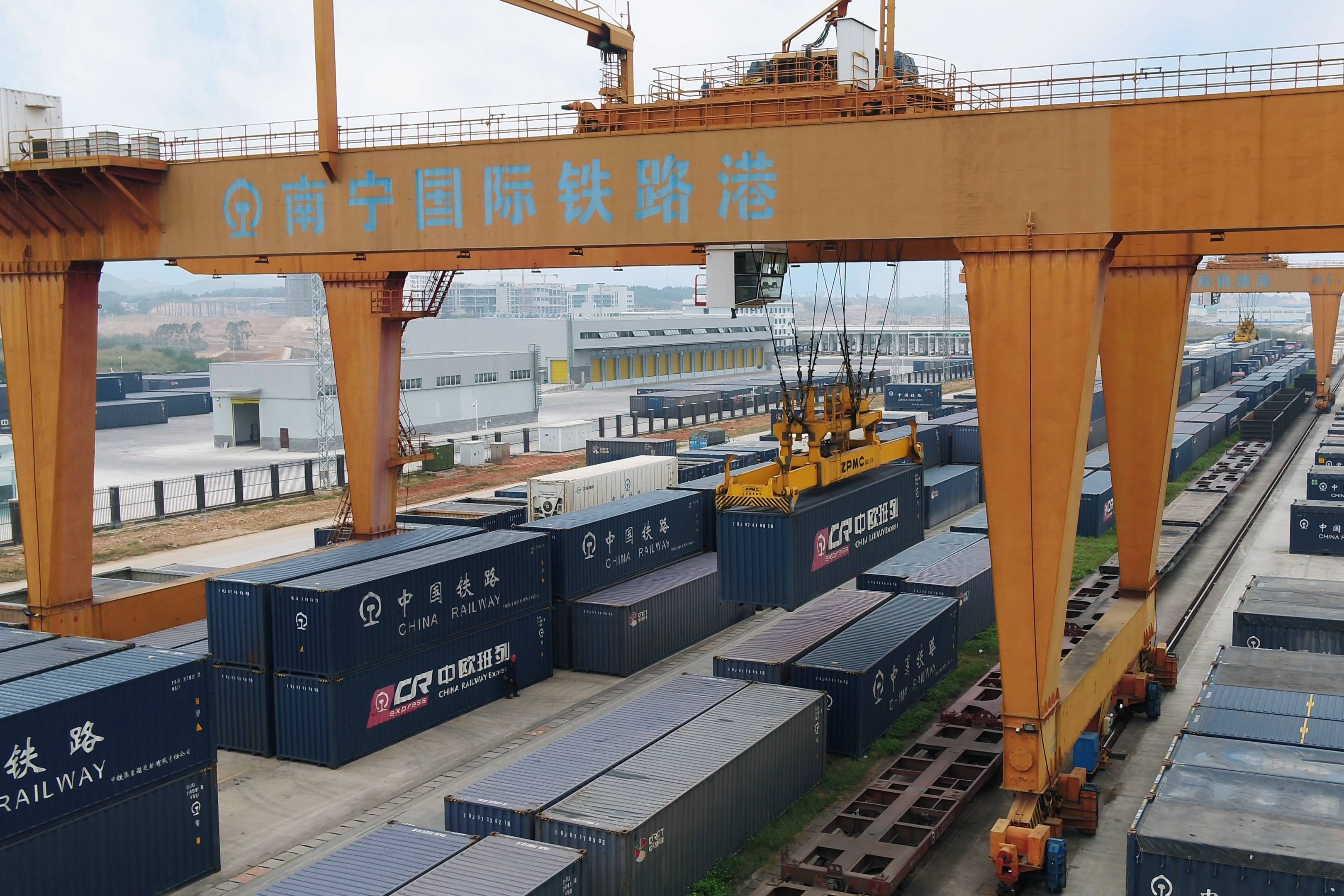Xinhua News Agency, Nanning, February 2. On February 1, the Regional Comprehensive Economic Partnership (RCEP), which has been implemented since January 1 this year, coincided with the “full moon” and officially entered into force for South Korea. In the past month, this free trade agreement with the largest population, the largest economic and trade scale and the most potential for development in the world has brought tangible dividends of tariff reduction to regional economic and trade exchanges.
The picture shows the container hoisting operation site of the international freight train of Nanning International Railway Port. Xinhua News Agency (Photo courtesy of China Railway Nanning Bureau Group Co., Ltd.)
One of the great benefits brought to enterprises after RCEP comes into effect lies in the reduction of import costs and the increase in export opportunities brought about by the reduction of tariffs. According to the agreement, the final proportion of zero-tariff products in RCEP goods trade will exceed 90%, which will bring new opportunities for industrial development in the region.
In the last month, Liu Donggui, general manager of Thailand’s Guitai Company, who has been engaged in the export of agricultural products for many years, no longer worries as much about the number of export orders as before. In his view, the change stemmed from the implementation of RCEP.
In recent years, Thailand Guitai Company has exported many Thai fruits such as durian and coconut. “After RCEP takes effect, agricultural products can be exported to countries in the region more easily. We no longer worry about the export volume, but pay more attention to improving the quality of our products and ensuring that our products meet export standards.” He said that RCEP is like a cornucopia, bringing More market orders will boost farmers’ confidence in planting.
On the day RCEP came into effect, tariffs on a large number of products were immediately reduced to zero. Among them, the immediate zero-tariff ratio between China and ASEAN, Australia and New Zealand exceeds 65%, the immediate zero-tariff ratio with South Korea reaches 39% and 50%, and the immediate zero-tariff ratio with Japan reaches 25% and 57% respectively.
Through RCEP, China and Japan reached a bilateral tariff reduction arrangement for the first time. This brings confidence to the development of Chinese and Japanese import and export enterprises.

The picture shows the customs officer of Wuzhou Customs issued an RCEP certificate of origin for a company to help develop the Japanese market. (Photo courtesy of Nanning Customs, taken on January 29)
Guangxi Baise Xinghe Aluminum Co., Ltd. exports aluminum foil to Japan all year round. The tariff rate of aluminum foil in Japan under RCEP has been reduced from 7.5% to 7%. The company’s products enter Japan this year to enjoy a 0.5% tariff preference. It has only been a month since RCEP came into effect, and the company has issued three RCEP certificates of origin for three batches of aluminum foil exported to Japan, helping traders save a lot of tariffs.
“In the past, nearly 1,500 tons were exported to Japanese traders every year. Now, due to favorable effects such as tariff concessions, it is expected to increase to more than 2,000 tons this year.” Lu Qichao, sales manager of Guangxi Baise Xinghe Aluminum Co., Ltd., said that the two sides are currently expanding The cooperation has reached a preliminary consensus, which will promote the substantial growth of the business of exporting products to Japan.
High quality, affordable and convenient – the entry into force of RCEP also brings three major benefits to consumers.
Japanese electrical appliances, Korean cosmeceuticals, Thai durian, and Australian milk powder are all “regular customers” in the shopping cart of Ms. Li, a citizen of Nanning. “Tariffs have been lowered, and imported goods with high prices have gradually become ‘people-friendly’, and our consumers can buy more and cheaper ‘foreign goods’,” she said.
Cui Fan, a professor at the University of International Business and Economics, believes that with the entry into force of RCEP, many consumer goods between China and relevant countries have been reduced to zero tariffs, and the Chinese people can buy relevant goods at cheaper prices and gain benefits.
After the tax reduction is completed, China’s imports of coconut water, pineapple products, and paper products from ASEAN, as well as induction cookers and electric ovens imported from Japan, will be gradually exempted from tariffs, and more high-quality and inexpensive products will enter consumers’ shopping carts.
Statistics from China’s customs show that in 2021, China’s imports and exports to the other 14 RCEP member countries will be 12.07 trillion yuan, an increase of 18.1%, accounting for 30.9% of China’s total foreign trade value. Nie Xinyu, director of the Legal Affairs Department of the Guangxi Council for the Promotion of International Trade, said that the tariff reduction under RCEP not only brings tangible benefits to the import and export of enterprises, but also makes the cross-border economic and trade cooperation more stable and closer, and at the same time brings more benefits to the people in the region. .
The Chinese government has done a lot of work to promote the implementation of the RCEP. While implementing the binding obligations one by one according to the timetable, it has also deepened the reform of delegating power, regulating services, and actively implementing non-binding obligations. The implementation of a series of systems and policies has promoted the continuous improvement of the business environment, people can buy cheaper items, and enterprises have gained more space for development.
Bai Ming, deputy director of the International Market Research Institute of the Chinese Academy of Commerce, believes that among the important engines of world economic development, both North America and Europe have platforms to promote regional economic integration. However, the Asian region is relatively loose, and the industrial chain lacks synergy and resilience. With the implementation of RCEP, this phenomenon is improving, and people in the region are gradually enjoying the development dividends brought about by regional economic integration. (Reporters Pan Qiang, Zhou Wenqi, Zhu Lili, Zhao Huan)Return to Sohu, see more
Editor:
Disclaimer: The opinions of this article only represent the author himself, Sohu is an information publishing platform, and Sohu only provides information storage space services.
